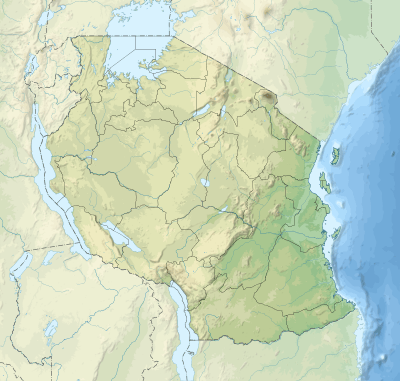Amani Nature Reserve
| Amani Nature Reserve | |
|---|---|
|
| |
 | |
| Type | Nature reserve |
| Location | Tanga, Tanzania |
| Coordinates | 5°05′S 38°40′E / 5.083°S 38.667°ECoordinates: 5°05′S 38°40′E / 5.083°S 38.667°E |
| Area | 8,380 ha |
| Created | 8 May 1997 |
| Operated by | Forestry and Beekeeping Division, Ministry of Natural Resources and Tourism |
| Website |
www |
The Amani Nature Reserve is a protected area located within the Muheza and Korogwe Districts in the Tanga Region of Tanzania, in tropical East Africa.
The nature reserve was established in 1997 in order to preserve the unique flora and fauna of the East Usambara Mountains. The East and West Usambara Mountains are a biodiversity hotspot. The Amani Nature Reserve includes tropical cloud forest habitats.
Reserve
The Amani Nature Reserve was established in 1997 in a forested area in the East Usambara Mountains with an area of 83.8 km2 (32 sq mi), including the Amani Botanical Garden of 3 km2 (1.2 sq mi) and a further 10.7 km2 (4.1 sq mi) of forest managed by local tea estates. Traditionally, people living in villages adjacent to the reserve have used the forest as a source of timber, firewood and medicinal plants, a place to gather plants, bush meat, honey and fruit for consumption and a source of live birds, amphibians, reptiles and invertebrates for international trade.[1]
Flora
The forests in the reserve have been described as intermediate evergreen forests or submontane evergreen forest, a type of vegetative cover that tends to grow on the seaward side of both the West and East Usambaras. The dominant trees are Allanblackia stuhlmannii, Isoberlinia scheffleri, Macaranga capensis, Cephalosphaera usambarensis, Myrianthus holstii., Newtonia buchananii and Parinari excelsa.[2]
A growing problem in the area is the presence of the invasive West African tree Maesopsis eminii. This tree germinates readily from seeds which are spread by birds, springs up in gaps in the canopy and outperforms native tree seedlings, displacing rare endemics and reducing biodiversity. The forests of East Usambara have long been separated from other forests and their isolation makes them more vulnerable to invasive species such as M. eminii.[3]
Fauna

The fauna of the Usambara Mountains has been compared to that of the Galápagos Islands in terms of its richness and biological importance. The area of the Amani Nature Reserve is better studied than many other parts of the range with numerous endemic invertebrates dependent on the native moist forest cover including mites, spiders, freshwater crabs, dragonflies, beetles, butterflies, millipedes and molluscs.[4]
There are few large mammals in the reserve. Duiker and bushpig are plentiful and there are two species of monkey, but the elephants and leopards that used to inhabit the area are no longer present.[2] The elusive long-billed forest warbler (Artisornis moreaui) is known from the reserve and from one other locality, Mount Namuli in northern Mozambique, 1,000 km (600 mi) away.[5][6]
Some of the endemic animals are named after the mountains in which the nature reserve is set, and these include the Usambara weaver (Ploceus nicolli), Usambara alkalat, Usambara hyliota (Hyliota usambara) and the Usambara eagle-owl (Bubo vosseleri). Others are named after the reserve, and these include the Amani sunbird (Hedydipna pallidigaster) and the Amani tailorbird. There are also endemic tree frogs and chameleons unique to the area.[7]
See also
- Flora of East Tropical Africa
- Mkomazi National Park
References
- ↑ Roe, Dilys (2002). Making a Killing Or Making a Living: Wildlife Trade, Trade Controls, and Rural Livelihoods. IIED. p. 61. ISBN 978-1-84369-215-7.
- 1 2 Hamilton, Alan Charles; Bensted-Smith, R. (1989). Forest Conservation in the East Usambara Mountains, Tanzania. IUCN. pp. 32, 83. ISBN 978-2-88032-965-5.
- ↑ Hamilton, Alan Charles; Bensted-Smith, R. (1989). Forest Conservation in the East Usambara Mountains, Tanzania. IUCN. p. 12. ISBN 978-2-88032-965-5.
- ↑ Hamilton, Alan Charles; Bensted-Smith, R. (1989). Forest Conservation in the East Usambara Mountains, Tanzania. IUCN. pp. 350–352. ISBN 978-2-88032-965-5.
- ↑ BirdLife International (2012). "Artisornis moreaui". IUCN Red List of Threatened Species. Version 2013.2. International Union for Conservation of Nature. Retrieved 24 January 2016.
- ↑ Philip Briggs (2009). Northern Tanzania: With Kilimanjaro and Zanzibar. Bradt Travel Guides. p. 21. ISBN 978-1-84162-292-7.
- ↑ "Amani Nature Reserve". Amani Forest Camp. Retrieved 24 January 2016.
| Wikimedia Commons has media related to Usambara Mountains. |
